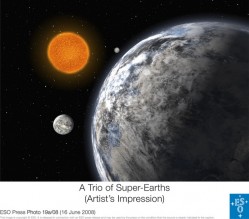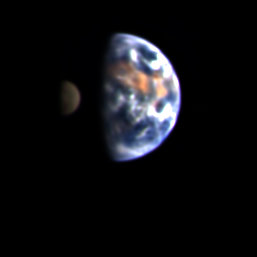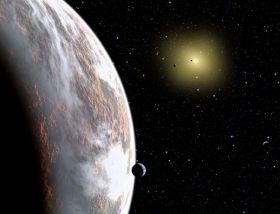With yesterday’s announcement about finding a batch of so-called “super-Earths†– rocky alien worlds a few times more massive than our own – as well as another announcement back in May that 45 relatively low mass planets had been found, it’s obvious astronomers are constantly improving on their techniques to find new worlds. While the vast majority of the almost 300 previously discovered exoplanets are Jupiter-like gas giants, the new discoveries of large numbers of small planets – and especially that at least three of them orbit one star — suggests that they are abundant in our galaxy, and may outnumber Jupiter-sized giants by 3 to 1. But how much like Earth are these alien worlds?
Super-Earths are planets that have than ten times or less the mass of Earth. The three planets around the star HD 40307 have masses of 4.2, 6.7, and 9.4 times the mass of the Earth. They orbit their star with periods of 4.3, 9.6, and 20.4 days, respectively. That’s a short orbital period, meaning they are very close to the star. Since they are close to the star, astronomers believe its likely they are terrestrial, rocky-type planets rather than gas giants like Jupiter and Saturn. But also, being so close to the star means they are very warm – perhaps 1000 degrees Celsius. This would not be a pleasant or probable environment for life as we know it to take a foothold. But we don’t know for sure, and since we are curious creatures, we want to know more about these planets.

The observatory that made the discovery of the 3 planets around HD40307, as well as the 45 planets that were announced back in May is the High Accuracy Radial Velocity Planet Searcher (HARPS) survey based at the European Southern Observatory in La Silla, Chile. Astronomers spotted them by recording how each planet’s gravitational tug makes its parent star wobble.
But now astronomers know these planets are there, they can try other methods of studying the planets to glean some detailed information about what these planets are like. For years, astronomers have been waiting for a super-Earth to be found with an orbit that “transits†its parent star: in other words, it passes directly in front of the star as viewed from Earth. When exoplanets have short orbital periods, the likelihood of being able to observing transits increases. These new planets fit that category.
Being able to observe transits would give astronomers data to help figure out many of the planet’s characteristics, from measuring its radius to deducing its internal structure to “seeing” its atmosphere.
Getting information about the planet’s atmosphere would be especially exciting. By watching for changes in a star’s spectrum as it filters a fraction of the star’s light during a transit, the presence of methane and water vapor in the gaseous atmosphere could be revealed.

A few satellites are capable of watching for a transit, among them the Canadian MOST satellite. Another is the recycled Deep Impact spacecraft that is hosting the EPOCh (Extrasolar Planet Observation and Characterization) mission. So far, 4 new planets have been found with this spacecraft, using the transit method, and the goal of the mission is to find an exoplanet smaller than Earth. Also, EPOCh hopes to be able to identify features on an exoplanet, such as continents and oceans. Exciting prospect, indeed.
It’s only a matter of time until astronomers will be able to tell us how Earth-like these newly found Super Earths are.
Sources: New Scientist, Bad Astronomy, EPOCh


Surely they’ve confirmed that these wobbles are actually “wobbles” and they come from planets moving around the star?? I thought I had read (somewhere?) about astronomers detecting the atmosphere of one of these planets (a gas giant I think?)?
Either way it seems obvious to me there MUST be planets in all types of configurations, around all types of stars, and all over the universe!! I guess the question is how many?!!
Actually… I just looked up the gas giant I was thinking about (HD 209458b) and I think it was detected by Transit…. So it doesn’t confirm this radial/wobble method like I thought… Does anyone know if this is solid science or is there still some debate about the radial/wobble technique?? (aside from the space mirror guy)
Neat.
That’s a nice Stardust pic…
BTW, what is it called if it is rocky and has more than ten times the mass of Earth? A “giant-earth� Or is there a name? That one always confuses me.
Super-Earths would have more tectonic activity, hence making them more habitable. They could be on the outer edge of habitable zones and still have oasis of life with Yellowstone areas similar to Mid-Ocean Rift Valleys. On the bottom of their oceans would be hot ice because of the pressure of deeper oceans. Some of these may even be water worlds there–especially with Hot Jupiters, which theory says tend to help create them.
I like the Space Mirror guy better… But he wants $10,000 for the truth about the universe.. 🙁
How come all of these newly discovered systems are so different from ours? If systems form by essentially the same mechanism, shouldn’t they be more similar? You know, small rocky worlds close in and gas giants farther out. I know some variation is to be expected but these really seem odd. It’s not the sizes so much as the distances from their star. I mean their orbital velocities must certainly be approaching some physical limit. And could they really form at all where their orbits are now located? It’s hard to imagine a large body coalescing from a cloud moving so fast.
I’m not an expert on such things and haven’t checked to see how old these systems are.. but perhaps some of them were like ours… and the last of the planets are being sucked in.. Just a thought.
For the whole truth? And nothing but the truth, so help you [insert preference here]?
It seems like planets this close to a star would be more ike giant Mercuries. I would think all traces of an atmoshere would ber stripped off, except for possible out gassing from the rocks or vapors of metals such a lead.
Correction: … such as lead.
I doubt a planet with temperatures near 1000 C. would have oceans of any kind, let alone hot ice…even if they had a dark side because of no rotation.
More like Super Mercuries than super Earth’s.
It’s curious that they are finding both rocky and jovian planets so close in. Either planetary formation theory is way wrong (truly, we knew it was, the disposition of 99% of the angular momentum of an accretion disk is still unknown), or the detections are false. Could we be simply detecting multiple harmonics on the surfaces of stars with the wobble method, rather than absolute motions of the whole star? Could the dip in the light curve seen by the transit method be akin to huge sunspots, or something like an orbiting coronal mass ejection, perhaps a darker distention from a round or elliptical star? I would feel much more comfortable with a dual transit/wobble confirmation, I don’t think that has happened yet.
“It seems like planets this close to a star would be more ike giant Mercuries. I would think all traces of an atmoshere would ber stripped off, except for possible out gassing from the rocks or vapors of metals such a lead.”
If so, then why does Venus, closer to the Sun, no appreciable magnetic field (to deflect charged solar particles) and about .78 Earth mass* have a denser atmosphere than Earth?
Those theories of why the atmospehre of Mars is so thin, don’t seem to explain this.
* Hmm. If anything lived there, would they call Earth a ‘super Venus?”
Could principles of general relativity – namely frame dragging – cause larger gas giants to shrink in orbit over time?
Each type of star, its age, and the subcatagory of the star, determine its temperature. That determines its habitable zone. Red dwarfs have very narrow habitable zones close to them. That will help determine the type of planet it is as well as the materials. These are not by default extrasolar giant Mercuries. Titan, Triton, and Pluto are made of the same materials. We know there are dramatic differences between them. Red dwarfs might not produce sputtering, or the erosion of the atmospheres like a larger star. We might have a super Venus or two. Let’s wait and see what the data says before we jump to conclusions.
If we are detecting a big number of planets close to their stars, it is just because they are much easier to detect than planets like in our system. It does not mean that they are more common. They may well be exceptions. We’ll know once we refine the detection methods. And those planets on low orbits do not necessarily deny the planet formation theory – there are so many unknown factors, that we cannot know what got the planets so close. Collisions with extrasolar objects, or the gravitational effect of other stars passing close are only some of them.
They should start working on the Terrestrial Planet Finder mission again… oh well, at least Darwin and Kepler will launch, I’m really looking forward to it.
@Gary: He was talking about Super-Earths that orbit farther away from the star than the one which we’ve found so far
@Andy:
The planetary systems we tend to find seem odd compared to our own, because they happen to be the sort that we find easiest to detect with our current methods, ie. big, heavy planets in close orbit around their star.
=Random thoughts of a Mad scientist-
It sounds like we are almost able to find Earth size planets. It is a shame they canceled the Terrestrial planet finder Projects, the longer we neglect this area of science the longer it is before I get off this rock.
Someone should Link the support voucher website….errr if their is one.
In all the history of man if I miss the finding of earth-like, life bearing planets by one generation I will be mad at god!!!
And I’m not sure that will go over well so get Finding!
I agree with Bill,
Imagine the seasons with a 20 days orbital period assuming its tilted.
Joe.
With that much more mass, would not the surface gravity be that much greater than Earth’s?
All other things considered, no human could ever set foot on these worlds or risk being crushed to death!
Re:”With that much more mass, would not the surface gravity be that much greater than Earth’s?
All other things considered, no human could ever set foot on these worlds or risk being crushed to death!” Earth is the densest planet in our solar system, and Sol is relatively highly metalliferous. SuperEarths are probably less dense, and with a larger radius, so a tolerable 1.5 – 2.0 Gs is possible. As out techniques and equipment improves, the size of detectable extrasolar planets will decrease, but the unusual way our Earth/Moon formed means extremely few similar sized planets will be remotely Earthlike.
I think its a load of crap personaly 🙂
yeh coz thats not my name
Uranus ?
@BOB
Bob, why do you insist in sayin this about uranus ?
Uranus is a beautiful place to be
thats why i fancy you babe 😛